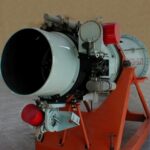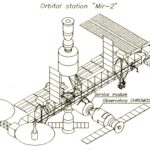 The project was developed in 1973-1978 under the leadership of G.A. Gurzadyan to obtain spectral images of the starry sky using a wide-angle 900-mm telescope.
The project was developed in 1973-1978 under the leadership of G.A. Gurzadyan to obtain spectral images of the starry sky using a wide-angle 900-mm telescope.
CEPHEUS: Space Observatory Project
 Cepheus is an astrophysical observatory placed into orbit around the Earth to conduct long-term photoelectric measurements of flare stars in the far ultraviolet region – U0 (3800-3100 A), U1 (3100-2500 A) and U2 (2500-1800 A), as well as X-rays. Cepheus was to be a stabilized satellite.
Cepheus is an astrophysical observatory placed into orbit around the Earth to conduct long-term photoelectric measurements of flare stars in the far ultraviolet region – U0 (3800-3100 A), U1 (3100-2500 A) and U2 (2500-1800 A), as well as X-rays. Cepheus was to be a stabilized satellite.
DENEB: Lunar Observatory Project
 The Deneb observatory, developed in the 1960s and 1970s, was designed to record the spectra of stars of various spectral classes in the ultraviolet from 900 to 4000 A using a telescope with a spectrometer. The observatory was to operate in stationary conditions from the surface of the Moon.
The Deneb observatory, developed in the 1960s and 1970s, was designed to record the spectra of stars of various spectral classes in the ultraviolet from 900 to 4000 A using a telescope with a spectrometer. The observatory was to operate in stationary conditions from the surface of the Moon.
ORION-3,4,5: space observatories
 After the successful completion of the SOYUZ-13 – ORION-2 flight, a decision was made to create space observatories ORION-3, 4, 5 with increased stabilization accuracy and several other tasks. Thus, ORION-4 was to have a telescope with LiF optics. ORION-5 was intended to obtain direct, rather than spectral, photographs of the starry sky.
After the successful completion of the SOYUZ-13 – ORION-2 flight, a decision was made to create space observatories ORION-3, 4, 5 with increased stabilization accuracy and several other tasks. Thus, ORION-4 was to have a telescope with LiF optics. ORION-5 was intended to obtain direct, rather than spectral, photographs of the starry sky.
ASHOT: Schmidt orbital telescope
 In 1989-1991, SKB Granit developed a project for a large orbital telescope of the Schmidt system – ASHOT (Astrophysical Schmidt Orbital Telescope) to solve a wide range of astronomical problems:
In 1989-1991, SKB Granit developed a project for a large orbital telescope of the Schmidt system – ASHOT (Astrophysical Schmidt Orbital Telescope) to solve a wide range of astronomical problems:
ASTRON-2: precision stabilization system
 In 1989-1991, right up until the collapse of the USSR, SKB Granit was working on creating a precision guiding system for the large orbital telescope T-170 under the promising SPECTRUM-UV project, which is a natural continuation of the ASTRON project.
In 1989-1991, right up until the collapse of the USSR, SKB Granit was working on creating a precision guiding system for the large orbital telescope T-170 under the promising SPECTRUM-UV project, which is a natural continuation of the ASTRON project.
 The main objective of the Chromos space orbital observatory is to obtain spectral and photometric information about stars and star-like objects (galaxies, nebulae, quasars) in the ultraviolet region – shorter than 3000 A to 1700 A and in a mass manner, i.e. with the simultaneous recording on one frame of spectral images or direct images of hundreds and thousands of stars, galaxies, etc.
The main objective of the Chromos space orbital observatory is to obtain spectral and photometric information about stars and star-like objects (galaxies, nebulae, quasars) in the ultraviolet region – shorter than 3000 A to 1700 A and in a mass manner, i.e. with the simultaneous recording on one frame of spectral images or direct images of hundreds and thousands of stars, galaxies, etc.
 The VESTAL space astrophysical observatory was designed to obtain information on the emissivity of celestial objects in the form of direct images and spectrograms in the far ultraviolet region – from 500 A to 100 A and shorter.
The VESTAL space astrophysical observatory was designed to obtain information on the emissivity of celestial objects in the form of direct images and spectrograms in the far ultraviolet region – from 500 A to 100 A and shorter.
Last Updated on 2024.12.26